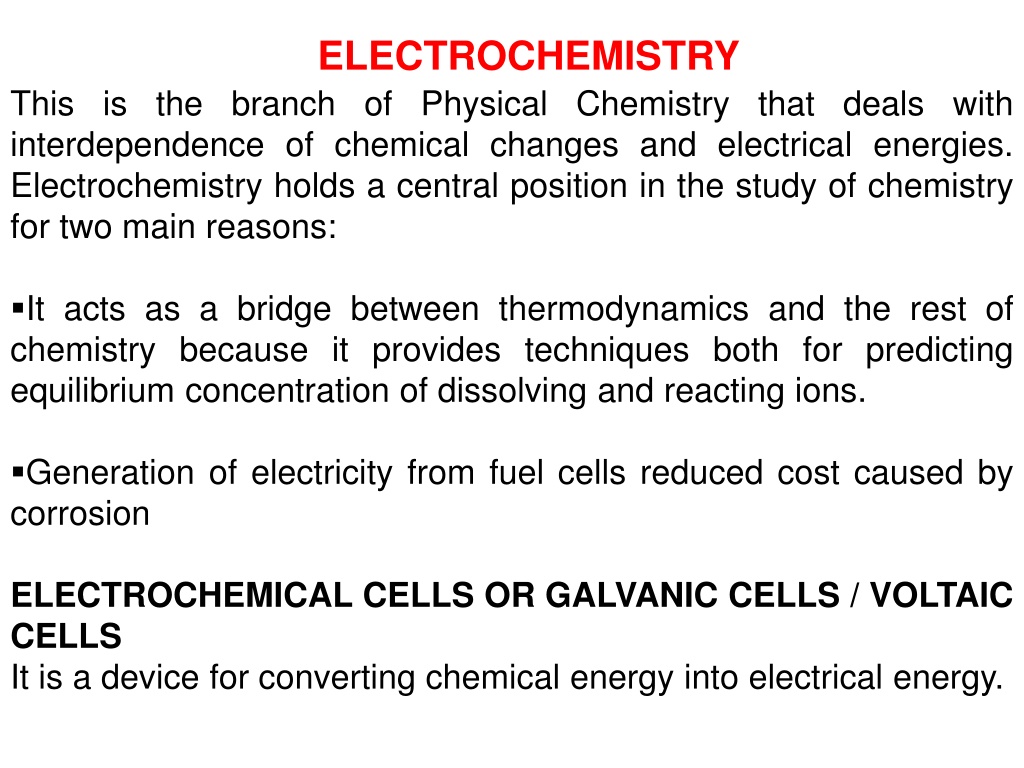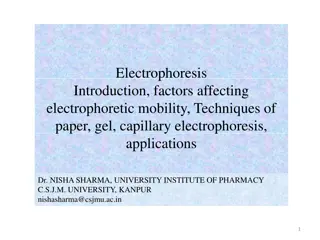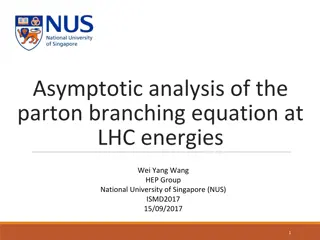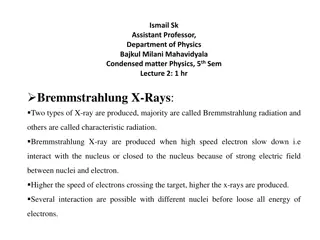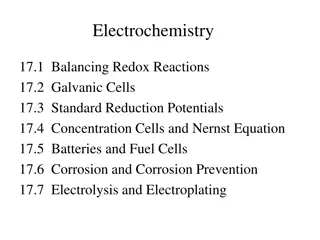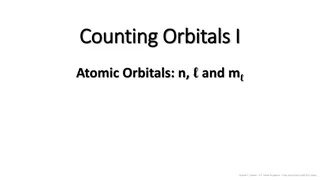Understanding Electrochemistry: The Interplay of Chemical Changes and Electrical Energies
Electrochemistry, a branch of Physical Chemistry, explores the relationship between chemical reactions and electrical energies. It serves as a vital link between thermodynamics and other areas of chemistry, offering insights into equilibrium concentrations and facilitating the generation of electricity. Through electrochemical cells like galvanic cells, chemical energy is converted into electrical energy, as demonstrated by examples such as the Daniell Cell and Zinc-Acid Cell. Various conventions are followed in electrochemical cells to represent the reactions and potentials involved.
Uploaded on Oct 03, 2024 | 0 Views
Download Presentation

Please find below an Image/Link to download the presentation.
The content on the website is provided AS IS for your information and personal use only. It may not be sold, licensed, or shared on other websites without obtaining consent from the author. Download presentation by click this link. If you encounter any issues during the download, it is possible that the publisher has removed the file from their server.
E N D
Presentation Transcript
ELECTROCHEMISTRY This is the branch of Physical Chemistry that deals with interdependence of chemical changes and electrical energies. Electrochemistry holds a central position in the study of chemistry for two main reasons: It acts as a bridge between thermodynamics and the rest of chemistry because it provides techniques both for predicting equilibrium concentration of dissolving and reacting ions. Generation of electricity from fuel cells reduced cost caused by corrosion ELECTROCHEMICAL CELLS OR GALVANIC CELLS / VOLTAIC CELLS It is a device for converting chemical energy into electrical energy.
A chemical reaction occurs with the production of an electric potential difference between two electrodes resulting in a flow of current which lead to the performance of work and thus transforms chemical energy into work. The galvanic cell usually consists of two electrolytic solutions into which two electrodes of different materials are dipped. Example is the DANIELL CELL. DANIELL CELL Originally: It consists of Zn electrode immersed in dilute H2SO4 and copper electrode immersed in CuSO4. Later: The H2SO4 was replaced by ZnSO4 solution to give more stable electricity. If the molalities of the two solutions are 1 molKg-1 (1 m), the cell is called a STANDARD CELL.
When the two electrodes are connected by a metallic wire, the cells start producing current. The reactions are: At ANODE: Because of the higher electrolytic pressure of Zn, it passes into solution as zinc ions (Zn2+) liberating electrons. Zn Zn2+ + 2e- At CATHODE: The electrons liberated at the anode travel along the external circuit and are used at the copper electrode where Cu2+ gain these electrons and are discharged as metallic copper. Cu2+ + 2e- Cu The net chemical change is called cell reaction Zn + Cu2+ Zn2+ + Oxidation is the process of electron loss while reduction is the process where electron is gained. Cu Thus for Daniell cell, oxidation takes place at the zinc electrode and reduction is taking place at the copper electrode. It is the energy of this reaction which is converted into electrical energy.
ZINC-ACID CELL: It is the simplest voltaic cell which consists of a zinc plate and a copper plate immersed in dilute H2SO4. On connecting the two plates through a metallic wire, current flows from the zinc plate (anode) to the copper plate (cathode). The reactions are: At Anode: At cathode: 2H+ The cell reaction is: Zn + Zn + 2e- Zn2+ + 2e- (oxidation) (reduction) H2 2H+ Zn2+ + H2 ELECTROCHEMICAL CONVENTIONS Certain conventions are followed regarding electrochemical cells as follows: 1. A half cell, such as a strip of zinc immersed in a solution of Zn2+ ion of concentration m is indicated as Zn Zn2+ (m) The vertical line denotes a solid phase in contact with a liquid phase
2. A galvanic cell may be represented as Zn Zn2+ (m1) C2+ (m2) Cu The two vertical lines represent liquid function 3. The electrode potential is given a +ve sign if the electrode reaction involved reduction and a ve sign if the electrode reaction involves oxidation. 4. The e.m.f. of a cell is the algebraic sum of the potentials of the two half cells. For example A A+ B+ B The e.m.f. of the cell is given by the potential difference of the two electrodes 5. The potential of the same electrode acting as anode will be opposite in sign to one acting as cathode
6. in order to express activities numerically, it is customary to choose for each component of an electrode a reference state known as the standard state. Example: Give the reaction and calculate the e.m.f. and free energy change at 298 K involved in the cell, Zn(s) Zn2+ + 2e- Zn Zn2+ (a = 1) Cu2+ (a = 1) Cu given that EZn,Zn2+ = +0.761 V; ECu2+,Cu = +0.339 V. Solution The cell reaction is Zn(s) Zn2+ + 2e- Cu2+ + 2e- Cu(s) Zn(s) + Cu2+ Zn2+ + Cu(s) Eocell = EoCu2+,Cu - EoZn2+,Zn = 0.339 (-0.761) = 1.10 V The standard free energy change G = - nFEo = -2 x 96500 x 1.1 = -212300
TYPES OF ELECTROCHEMICAL CELLS Two main types exist, they are 1/ chemical cells and 2/ concentration cells (a)Chemical cells: Electrical energy is produced from the energy change accompanying a chemical reaction or a physical process (b) Concentration cells: Electrical energy is produced from the energy change accompanying the transfer of solute or material from one concentration to another. Relation between electrical energy and free energy The electrical work done by the cell per mole of the reactant consumed = nFE where n = the no of electrons liberated at one electrode (the valency of the metal), E = the e.m.f. of the cell, F = Faraday (1 Faraday = 96500 coulombs) The free energy of the cell system decreases by an amount G (1) G = - nFE The free energy is given by
G = H + TdG (2) dT p Where H is the change in the heat content of the system. From equation(1) we can write -nFE = H + Td G dT p dE dT -nFE = H - nFT p nFE = - H + nFTdE (3) dT p dE dT 1. If = 0, the e.m.f. of cell does not alter the temperature. It means that p decrease in heat content will be equal to the electrical energy. dE dT 2. If = +ve, the e.m.f. of the cell increases with temperature. It means that p the electrical energy will be greater than the heat of reaction i.e. the cell will take heat from the surroundings.
dE dT 3. If = -ve, the e.m.f. of the cell decreases with temperature. p It means that the electrical energy will be greater than the heat of reaction. i.e. the cell will give out heat while working. 4. At absolute zero (T = 0 K) equation 3 is nFE = - H. It then follows from equation 4 that the decrease in heat content will be equal to the electrical energy obtainable from the cell. REVERSIBLE AND IRREVERSIBLE CELLS (a) Reversible cells: The cell is sending out very small current so that the cell reaction always remains virtually in equilibrium. A reversible cell must satisfy the following conditions: (i) If an e.m.f. exactly equal to that of the cell is supplied from an external source, the chemical reaction taking place in the cell will stop.
(ii) if the external e.m.f. infinitesimally greater than the actual e.m.f. of the cell is applied to it, the current will start flowing in opposite direction and the cell reaction gets reversed. (iii) If the external e.m.f. infinitesimally less than the actual e.m.f. of the cell is applied to it, the current will flow from the cell which is proportional to the chemical or other change occurring therein. The Daniell cell is a typical example of a reversible cell. Zn ZnSO4(aq) CuSO4(aq) Cu If the cell is connected to an external source of e.m.f. less than the e.m.f. of the cell, the chemical reaction taking place in the cell is Zn + Cu2+ Zn2+ + Cu But if the e.m.f. from the external source is greater than that of the cell, the reaction in the cell is in the opposite direction. Hence the cell works as a reversible cell.
Irreversible cells: A cell that does not satisfy the above conditions is said to be irreversible. Example: Zn H2SO4(aq) Cu When the two electrodes are connected, the following reactions take place: At anode At cathode Zn 2H+ + 2e- Zn2+ + 2e- H2 The complete cell reaction is: Zn + 2H+ Zn2+ + H2 When the cell is connected to an external source of e.m.f. slightly greater than its own e.m.f., the following reaction will take place. Cu Cu2+ + 2e- 2H+ + 2e- H2 Cu + 2H+ Cu2+ + H2
From the above it is evident that the cell does not satisfy the conditions of reversibility and hence it is an irreversible cell. STANDARD ELECTRODE POTENTIAL When all the substances taking part in a reaction in a reversible cell are maintaining at unit activity i.e. in their standard states, the e.m.f. of any electrode in these conditions is known as standard electrode potential of the given cell (Eo) Derivation (1) Go = -nFEo Consider a reversible process aA + bB + lL + mM + .. From equation (2) (2)
Increase in free energy Go at constant temperature is governed by Vant Hoff s reaction isotherm. Thus, - Go = RTlogeK - RTlogeaLlaMm/aAaaBb If the reactants and the products are measured in their standard states, the activities will be one in each case, thus - Go = RTlogeK Eliminating Go between (1) and (4), we get nFEo = RTlogeK at any arbitrary concentrations of reactant and products, the e.m.f. of the cell is given by Go = -nFE Substituting equations (6) and (5) in (3) nFE = nFEo - RTlogeaLlaMm/aAaaBb If aA, aB and aL, aM .. are unity, then equation (7) becomes Eo = E Hence, The potential of the electrode when the activities of the reactants and products are unity (3) (4) (5) (6) (7)
From equation (5), Eo = (RT/nF)logeK At 25 oC this becomes, Eo = (0.05916/n)log10K These equations provide very important method for calculating Gibbs free energy changes and equilibrium constant. Examples 1. Calculate the equilibrium constant at 25 oC for the reaction occurring in the Daniell cell, if the standard e.m.f. is 1.100 V. Solution The reaction is Zn + Cu2+ Zn2+ + Cu Therefore n = 2, hence log10K = 2 x 1.100/0.05916 = 37.19 K = 1.5 x 1037 2. Using the following information, 2H+ + 2e- H2 Eo = 0; Fe3+ + e- Fe2+ Eo = 0.771 V. Calculate the equilibrium constant for the reaction; H2 + 2Fe3+ 2H+ + 2Fe2+ Solution
The Eo value for the process for which n = 2 is 0.771 V since the e.m.f. of 0.771 V also applies to the process 2Fe3+ + 2e- 2Fe2+ Therefore 0.771 = (0.05916/2)log10K Hence, K = 1.16 x 1026 3. Calculate Eo for the process Cu+ + e- Cu making use of the following Eo values: Cu2+ + e- Cu+ E1o 0.153 V; Cu2+ + 2e- Cu E2o = 0.337 V Solution The Go values for these two reactions are Cu2+ + e- Cu+ G1o = -1 x 0.153 x 96500 Jmol-1 Cu2+ + 2e- Cu G2o = -2 x 0.337 x 96500 Jmol-1 Substract (1) from (2) Cu+ + e- Cu G2o G1o = Go Therefore Go = (-2 x 0.337 x 96500) (-1 x 0.153 x 96500) = -0.521 x 96500 Jmol-1 From Go = -nFEo Eo = 0.521 V
THE NERNST EQUATION Consider the cell Pt, H2 H+ Cu2+ Cu in which the concentrations are not unity i.e. the molecules are not in their standard states. The overall cell reaction is H2 + Cu2+ 2H+ + Cu And the Gibbs energy change is [H+]2 [Cu2+] G = -RT[lnK ln However Go = -RTlnK = -nFEo, [H+]2 [Cu2+] G = -nFEo + ln Since G = -nFE [H+]2 [Cu2+] ln -nFE = -nFEo + RT Hence
[H+]2 [Cu2+] RT ln nF E = Eo - In general for the reaction aA + bB + yY + zZ + .. For which [Y]y[Z]z [A]a[B]b G = -nFEo + - RT ln And since G = -nFE, then [Y]y[Z]z [A]a[B]b RT ln nF E = Eo - This is known as the Nernst equation. Example: Calculate the e.m.f. of the cell Co Co2+ Ni2+ Ni
The concentrations are (a) [Ni2+] = 1 m and [Co2+] = 0.1 m (b) [Ni2+] = 0.01 m and [Co2+] = 1 m And the standard electrode potentials are Ni2+ + 2e- Ni Co2+ + 2e- Co Eo = -0.25 V Eo = -0.28 V Solution: The overall cell reaction is Co + Ni2+ Co2+ + Ni The standard e.m.f. is thus -0.25 (-0.28) = 0.03 V and n = 2. For (a); E = 0.03 0.05916/2 log10[Co2+]/[Ni2+] = 0.06 V For (b); E = 0.03 0.05916/2log101/0.01 = -0.029 V
ELECTROLYSIS The process of decomposition of an electrolyte by the passage of electric current through it is known as electrolysis. The mechanism of electrolytic conduction
Movement of ions during electrolysis FARADAY S LAWS OF ELECTROLYSIS Michael Faraday in 1833 studied the phenomenon of electrolysis and arrived at the following two conclusions known as Faraday s laws of electrolysis.
Faradays first law of electrolysis m Q; or m It (Q = It); or m = wIt When I = 1 ampere and t = 1 second, the above equation becomes m = w Therefore m = the mass of the substance produced or consumed when a current of 1 A for 1 s is passed through the electrolyte. For example, the w of silver is 0.001118. Example 1 What would be the mass of Ag deposited at the cathode if a current of 0.2 A is passed through a solution of AgNO3 for 30 min. Solution No of coloumbs = 0.2 A x 30 x 60 s = 360 C No of moles of e- = 360 C/9.632 x 104 Cmol-1 = 3.74 x 10-3 mol Ag+ + e- Ag(s)
Therefore, 3.74 x 10-3 mol of e- = 3.74 x 10-3 mol Ag The mass of Ag = 3.74 x 10-3 mol x 108 gmol-1 = 0.40 g Example 2 If a current of 0.1 A is passed for 10 hrs through acidified water at room temperature, what volume of O2 will be released? Solution At anode: OH- OH + e- 4OH- 2H2O + O2 i.e. 2H2O 2H2 + O2 Therefore, 4 moles of e-s will release 22.4 dm3 of O2 The no of Coloumbs passed = 0.1 A x 10 x 60 x 60 s = 3600 C The no of moles of e-s = 3600 C/96500 Cmol-1 = 0.0373 mol Volume of O2 = 22.4 dm3 x 0.0373/4 = 0.209 dm3
Faradays second Law of Electrolysis m E; m = constant x E; or m/E = constant When the same quantity of electricity is passed through different electrolytes, the above equation can be put as m1/E1 = m2/E2 = m3/E3= = constant Example 1: If the same current is passed through a solution of CuSO4 & AgNO3, the amount of Cu & Ag deposited at the cathode are proportional to their chemical equivalent i.e. 31.78 & 107.8 respectively. Cu2+ + 2e- Cu; equivalent weight of Cu = 63.5/2 = 31.78 g Ag+ + e- Ag; equivalent weight of Ag = 107.8/1 = 107.8 g Example 2: A constant current was passed through a solution of AuCl4- ions between gold electrodes. After a period of 10 min, the
Cathode increased in weight by 1.314 g. how much charge was passed and what was the current I? Solution: AuCl4- + 3e- Au + 4Cl- Moles of Au = 1.314 g/197 gmol-1 = 6.67 x 10-3 mol Q = 6.67 x 10-3 mol x 3 mol of e-s = 2.00 x 10-2 Faraday I = Q/t = (2.00 x 10-2) x (96500)/600 = 3.22 A
